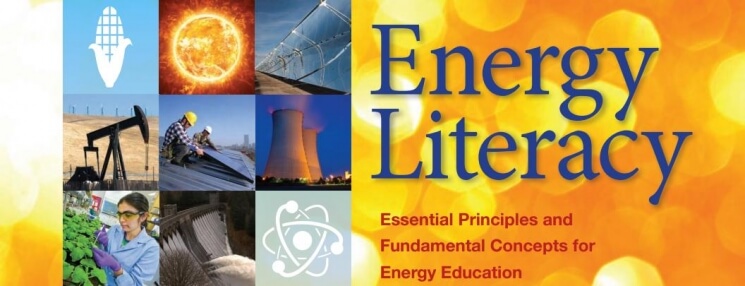Energy Literacy
 What is Energy Literacy?
What is Energy Literacy?
Energy Literacy is an understanding of the nature and role of energy in the world and daily lives accompanied by the ability to apply this understanding to answer questions and solve problems. The Energy Literacy Framework was founded and is run by the Office of Energy Efficiency and Renewable Energy's (EERE's) Technology-to-Market team.
• Knows how much energy they use, for what purpose, and where the energy comes from.
• Can assess the credibility of information about energy.
• Can communicate about energy and energy use in meaningful ways.
• Is able to make informed energy use decisions based on an understanding of impacts and consequences.
What is the Energy Literacy Framework?
Energy Literacy: Essential Principles and Fundamental Concepts for Energy Education is an interdisciplinary approach to teaching and learning about energy. The framework identifies seven Essential Principles and a set of Fundamental Concepts to support each principle. The guide does not seek to identify all areas of energy understanding, but rather to focus on those that are essential for all citizens K-Gray. It presents energy concepts that, if understood and applied, will help individuals and communities make informed energy decisions.
Who Led the Development of the Energy Literacy Document?
The Energy Literacy document is the culmination of public listening sessions and thousands of experts from diverse fields of study contributing to a dialogue about what an energy literate person should know and understand. This included over 20 recognized educational partners and 13 federal agencies that comprise the U.S. Global Change Research Program Partner agencies.
How Should We Approach Energy Literacy?
Energy Literacy looks at energy through the lens of natural science as well as social science. Energy issues require an understanding of civics, history, economics, sociology, psychology, and politics in addition to science, technology, engineering and mathematics. A comprehensive study of energy and curriculum designed using Energy Literacy should be interdisciplinary and use a systems-based approach to fully appreciate the complexities of energy issues.
Who is the Audience for the Framework?
The intended audience for the Energy Literacy document is anyone involved in energy education. Intended use of the document as a guide includes, but is not limited to, formal and informal energy education, standards development, curriculum design, assessment development, and educator training.
The Essential Principles and Fundamental Concepts
A note on the use of the Essential Principles and Fundamental concepts:
The Essential Principles, 1 through 7, are meant to be broad categories representing big ideas. Each Essential Principle is supported by six to eight Fundamental concepts! 1.1, 1.2, and so on. The fundamental concepts are intended to be unpacked and applied as appropriate for the learning audience and setting. For example, teaching about the various sources of energy (Fundamental Concept 4.1) in a 3rd grade classroom, in a 12th grade classroom, to visitors of a museum, or as part of a community education program will look very different in each case. Furthermore, the concepts are not intended to be addressed in isolation; a given lesson on energy will most often connect to more than one of these concepts.

















